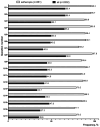Sleep and mental status as key factors to asthenopia in Chinese adults
- PMID: 40256037
- PMCID: PMC11947546
- DOI: 10.18240/ijo.2025.04.19
Sleep and mental status as key factors to asthenopia in Chinese adults
Abstract
Aim: To investigate the occurrence of eye asthenopia in Chinese adults and pinpoint the factors contributing to it using a 17-item Asthenopia Survey Questionnaire (ASQ-17).
Methods: A total of 2509 Chinese adults aged 18 and above from 30 regions in China participated in a cross-sectional online survey in February 2020. The survey utilized the ASQ-17, which had been proven reliable and validated for assessing asthenopia-related symptoms experienced in the past two weeks among the Chinese population. Data on demographics and living conditions, including age, gender, humidity, air quality in their residential areas, frequency of heightened anxiety or depression, daily duration of near vision activity, sleep duration, sleep quality, and history of eye surgery, were collected. Principal component analysis and multivariate logistic regression were employed to identify independent factors associated with asthenopia.
Results: Out of the 2502 participants, with an average age of 31±8y included in the analysis, asthenopia was prevalent in 35.2% of cases. Multivariate analysis revealed that the most influential risk factor was poor sleep and mental well-being, which encompassed shorter daily sleep duration, lower sleep quality, and more frequent feelings of heightened anxiety or depression [odds ratio (OR): 2.07, 95% confidence interval (CI): 1.88-2.29, P<0.001]. This was followed by each additional 2h of daily near vision activity relative to 4h (OR: 1.33, 95%CI: 1.21-1.45, P<0.001), and lower humidity and worse air quality in the residential area (OR: 1.10, 95%CI: 1.02-1.21, P=0.019).
Conclusion: Asthenopia is a common issue among Chinese adults, and preventative measures should focus on improving sleep and mental well-being. Further research targeting physiological exposure, different age groups or longitudinal studies to establish causality are needed to explore the role of sleep and mental status as an influencing factor.
Keywords: asthenopia; mental status; sleep duration; sleep quality.
International Journal of Ophthalmology Press.
Conflict of interest statement
Conflicts of Interest: Lin N, None; Chen X, None; Wu XT, None; Tian FY, None; Yang MY, None; Liu YS, None; Lyu F, None; Deng RZ, None.
Figures

Similar articles
-
Prevalence and determinants of asthenopia among ophthalmologists in China: a national cross-sectional survey.Front Public Health. 2023 Dec 29;11:1290811. doi: 10.3389/fpubh.2023.1290811. eCollection 2023. Front Public Health. 2023. PMID: 38222083 Free PMC article.
-
Nonlinear effects of humidex on risk for asthenopia among adults: a national cross-sectional survey in China.Front Public Health. 2025 Mar 13;13:1515672. doi: 10.3389/fpubh.2025.1515672. eCollection 2025. Front Public Health. 2025. PMID: 40182528 Free PMC article.
-
Prevalence of asthenopia and its risk factors in Chinese college students.Int J Ophthalmol. 2013 Oct 18;6(5):718-22. doi: 10.3980/j.issn.2222-3959.2013.05.31. eCollection 2013. Int J Ophthalmol. 2013. PMID: 24195055 Free PMC article.
-
Correlation between mental status and prevalence of asthenopia in Chinese college students.Graefes Arch Clin Exp Ophthalmol. 2024 Nov;262(11):3649-3660. doi: 10.1007/s00417-024-06551-5. Epub 2024 Jun 25. Graefes Arch Clin Exp Ophthalmol. 2024. PMID: 38916723
-
High Prevalence of Asthenopia among a Population of University Students.J Ophthalmic Vis Res. 2019 Oct 24;14(4):474-482. doi: 10.18502/jovr.v14i4.5455. eCollection 2019 Oct-Dec. J Ophthalmic Vis Res. 2019. PMID: 31875103 Free PMC article. Review.
References
-
- Chinese Optometric Association of Chinese Ophthalmological Society, Optometry Group of Chinese Ophthalmologist Association. Chinese expert consensus on the diagnosis and treatment of asthenopia (2024) Zhonghua Yan Ke Za Zhi. 2024;60(4):322–329. - PubMed
-
- Alhasan AS, Aalam WA. Magnitude and determinants of computer vision syndrome among radiologists in Saudi Arabia: a national survey. Acad Radiol. 2022;29(9):e197–e204. - PubMed
-
- Xu YP, Deng GY, Wang WH, et al. Correlation between handheld digital device use and asthenopia in Chinese college students: a Shanghai study. Acta Ophthalmol. 2019;97(3):e442–e447. - PubMed
LinkOut - more resources
Full Text Sources
Miscellaneous
